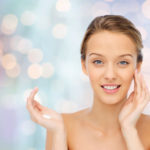Free Consultation in Central London
No obligation appointment with a surgeon
SKIN 101
An Ideal Skincare Regimen
Free Consultation in Central London
No obligation appointment
Click below to contact us

Introduction
There are so many skincare brands and lines being marketed, each claiming to be better than one another, it is increasingly difficult to filter out what are the most useful elements in a practical daily routine. This is a multi-part piece about a standard skincare regimen that will suit almost everyone and then, we will talk about more specific items that help a particular skin goal.
Here are the shortcuts to the Evidence Based Skincare Regimen Series!
- Cleansing
- Moisturising
- Sun Protection
- Anti-Aging Additions
3. Sun Protection
The link between skin cancer and accelerated aging with sun exposure is indisputable and much well designed research and observations have proved this. Taking out the aging aspects, UV exposure is the single most important causing factor for the majority of skin cancer. UV rays can be separated into UVA, UVB and UVC, depending on the wavelength. The relevant ones to skin are UVA and UVB as these are the two that reach the earth’s surface.
Effects of UV
The effects of UV radiation on the skin include short-term redness, inflammation, burn and tanning. The chronic, long-term effect that we see years later include the altering of skin immunity, aging and cancer. You may be able to see these differences when comparing heavily sun exposed sites (face, neck, arms) with skin that get little light (inner thighs, inner arms, abdomen). The visible changes in the skin include roughness, wrinkles, uneven tone and pigmentation, tiny blood vessels (telangiectasia), rough and pink patches (that may represent a pre-cancerous lesion). Protection from the sun will reduce the development of such signs. Sun protection goes beyond sunscreen lotion. It includes sun avoiding behaviour and protective clothing.
What Does SPF Mean?
Sunscreens use the SPF rating, which is defined as the UV dose required to develop a minimum erythema dose (MED) after an application of 2mg/cm2 of sunscreen. SPF 10 means that it can absorb 10x the dose of UV radiation before developing redness (erythema) compared to if you did not use the sunscreen. So if the intensity of UV generated at mid-day causes you to go red in 10 minutes, then the SPF 10 means that under the same conditions, you will get to the same redness in 100 minutes. SPF indicates protection from UVB rays with UVA effect more unpredictable. Your sunscreen will protect from UVB as standard, but not all will protect from UVA.
Types of Sunscreens
There are 2 main types of sunscreens – organic and inorganic. Organic ones, sometimes called chemical filters, absorb the UV radiation and re-emit it as heat. Inorganic ones, also called physical blockers, are made of particles that scatter and reflect the rays. Most commonly, these will be zinc oxide and titanium dioxide. The main problem with this type is that they have the telltale whiteish powder residue, but newer formulations can get around this problem to some extent. They also impart fewer irritant issues for those with sensitive skin. The latest sunscreens also contain anti-oxidants to reduce free radical damage (see other article on the causes of skin aging). They may contain plant derivatives or anti-oxidant vitamins.
How to Use Sunscreens
The recommendation is to wear a sunscreen every single day, regardless of whether the sun seems to be out or not. They should be applied half an hour before leaving the house and all sun-exposed areas covered. Ideally, it should be re-applied during the day, although understandably this may be impractical for some. The FDA recommends re-applying at least every 2 hours, more frequently if you have sweat a lot or have been in water.
Daily sunscreens should contain at least SPF 30 and be broad spectrum (meaning it covers UVA as well as UVB). At high level exposures (during beach holidays), then SPF 50+ should be applied and stricter re-application routine should be followed. Those with pigmentation issues (such as sun-spots, melasma or scar pigmentation), should also wear SPF 50 daily.
Next Steps...
How to incorporate your cleansing into your routine should be very individualised. It depends on your skin type, needs and other components of your overall regimen. At Lumaesthetic, we can discuss all of these points at your free consultation. There is no single treatment type that can improve everyone's skin health and facial aesthetics in the same way. It will be a personalised combination of different treatments and skin advice.
Read on for the next steps in our Evidence Based Skincare Regimen Series!
- Cleansing
- Moisturising
- Sun Protection
- Anti-Aging Additions
Popular Topics
How to optimise your skin consistently using robust medical evidence, rooted in science.
Avoid fads and be wise to extravagant marketing.
The Needle & Knife
With so many options for facial rejuvenation, how do surgeons choose the right procedure for our patients?
What Ages Skin?
We look at the main influences that have been shown to significantly affect the way and rate our skin ages.
1. Cleansing
Understand your cleansers and what works well for different skin types
2. Moisturising
Understand your moisturisers and what is most appropriate for your skin
3. Sun Protection
Understand why sun protection is one of the most important aspects of skincare
4. Anti-Aging
Scientifically proven anti-aging products







